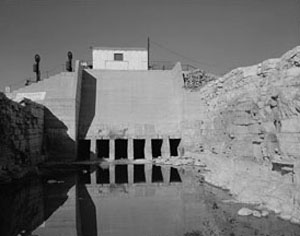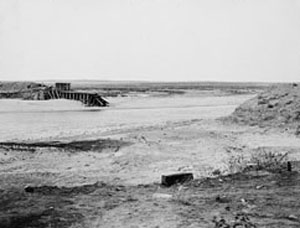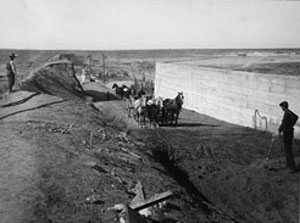
For all its ill luck, Avalon Dam has played a significant role in western irrigation history. First built in 1889 by private entrepreneurs on the Pecos River north of Carlsbad, New Mexico, Avalon was among the first irrigation dams in the United States to be constructed of loose rock with an upstream face of earth. Impressive as well was Avalon’s innovative sluice gate, which directed river water into the system’s Main Canal. The canal also boasted a striking feature--a wooden flume so long and wide that four mule teams could walk across it, side by side.
Avalon Dam was only four years old when flood waters breached its crest, damaging canals and the massive flume. That 1893 flood did not, however, dampen the enthusiasm of wealthy entrepreneur James John Hagerman, who had made a fortune from Colorado’s Mollie Gibson silver mine. Believing he could make the arid Pecos Valley bloom, Hagerman poured his money into rebuilding Avalon Dam, only to see a flash flood destroy it again in 1904.
The Pecos River, a tributary of the Rio Grande, proved an unreliable friend as it flowed out of the mountains near Santa Fe and into the generally flat plains of southeastern New Mexico, where temperatures could soar to 111 degrees in the summer. While the area received an average of only 12.5 inches of precipitation a year, the rain could come in torrents, washing down an arroyo (creek) or lifting the Pecos right out of its banks. The dangers hadn’t stopped local ranchers such as Charles B. Eddy and Pat Garrett from dreaming of turning the Pecos River Valley into an oasis. Eddy and Garrett (the former sheriff who killed Billy the Kid) formed an irrigation company, solicited outside financiers, including Hagerman, and began constructing substantial irrigation works, including the original Avalon Dam. As Hagerman and his associates became the dominant owners, they reorganized the company, started a railroad and promoted a new town called Eddy, the name later changed to Carlsbad, where the irrigation company set up shop in the First National Bank Building of Eddy.

Following the 1893 flood, the company hired 500 men and 165 horse teams to quickly rebuild Avalon Dam with an almost identical cross-section to the original dam. The flume and canals also were repaired in time for the 1894 growing season. In 1902-03, the Pecos Irrigation Company spent another $50,000 reinforcing the flume with concrete and four pairs of arches. Mark Hufstetler and Lon Johnson write that the massive, yet graceful, flume, “was a source of pride for the company and the Carlsbad community.” Measuring 497 feet long by 47 feet high, it reportedly was the largest irrigation flume in the United States.
The flume was barely complete, however, when a flash flood came roaring down the Pecos in October 1904, damaging not only the flume, but much of the canal system, as well as highway and railroad bridges in Carlsbad--and, for a second time, the hapless Avalon Dam. The flood and the valley’s unsuccessful attempts to find appropriate local crops all but spelled the end for the Pecos Irrigation Company. The story of failed private reclamation was not new in the American West. By 1900, 90 percent of private irrigation companies had gone bankrupt or closed.
Without irrigation, there could be no farming in the Pecos Valley, and settlers, who had been attracted to the region by the efforts of the irrigation entrepreneurs, were frantic. Wanting to rebuild but lacking finances, they formed the Pecos Water Users Association and began advocating aggressively for the Federal Government’s new Reclamation Service (today’s Bureau of Reclamation) to take over the project, an idea that appealed to the nearly bankrupt irrigation company.
In December of 1904, Reclamation engineers arrived to study the situation. As Reclamation evaluated, the Pecos Water Users Association raised $20,000 and, with design help from Reclamation engineers, performed temporary repairs on Avalon Dam--only to have the dam wash out again when a severe leak led to failure within hours of filling the reservoir. In November 1905, the Pecos Irrigation Company agreed to sell the remains of its systems to the Secretary of the Interior for $150,000.
Taking over the project, Reclamation set April 12, 1906, as the day it would open bids for rehabilitating what it called the Carlsbad Project, which included not only Avalon Dam but McMillan Dam and Reservoir, also built by private interests. McMillan was a storage dam, while Avalon served both to store water and divert it into the project’s Main Canal. The day came to open bids but, when no offers were placed on the table, Reclamation took over the project by force account, meaning Reclamation would do the work itself, from design to the hiring of subcontractors and laborers.

By June 1, 1906, construction was under way. Once again, Avalon Dam rose on the Pecos, its latest design reflecting many of the advances made in dam engineering since the original Avalon Dam was constructed in 1889. Avalon remained an earthen dam erected atop a rock-filled foundation, but this time Federal engineers added a thin, concrete and steel corewall and enlarged the spillways to withstand future flooding.
The new Avalon Dam, completed in 1907, was 1,025 feet long and up to 50 feet high. It still stands across the Pecos River, its height increased in 1912 and again in 1936; its crest now 58 feet high. Work done in the 1930s was performed by young men of the Civilian Conservation Corps, a New Deal work relief program. During the winter of 1911-12, Reclamation also incorporated two innovative cylinder spillway gates at Avalon, a design incorporated later into the intake towers at Hoover Dam. If a flood was anticipated, the gates could be raised, allowing the reservoir to lower rapidly.
By 1912, the Carlsbad Project was irrigating 15,000 acres and had attained a semblance of stability. In the early years of the 20th century, cotton and alfalfa were leading crops. Today, the project irrigates 25,000 acres along a 20-mile stretch of the Pecos River. Cotton and alfalfa remain the principal crops, although wheat, barley, oats, and vegetables also are produced in abundance.
Although title to the Carlsbad Project remains in the hands of the Federal Government, today the Carlsbad Irrigation District, created in 1932 by water users, operates and maintains the system. The transfer from Federal to local control took place on October 1, 1949, beginning yet another chapter in the story of irrigation in the Pecos River Valley. The Carlsbad Project is a significant example of how a private irrigation effort in the American West evolved into a publicly sponsored Reclamation project and then back to a locally operated water district. Because of its significance, the irrigation district was designated a National Historic Landmark in 1964. The historic district comprises seven buildings and 22 structures, including Avalon Dam and reservoir, the Main Canal, Pecos River flume, and the First National Bank of Eddy in downtown Carlsbad, which for many years housed the offices of the Carlsbad Irrigation District.
Visit the National Park Service Travel Bureau of Reclamation's Historic Water Projects to learn more about dams and powerplants.
Last updated: January 13, 2017
